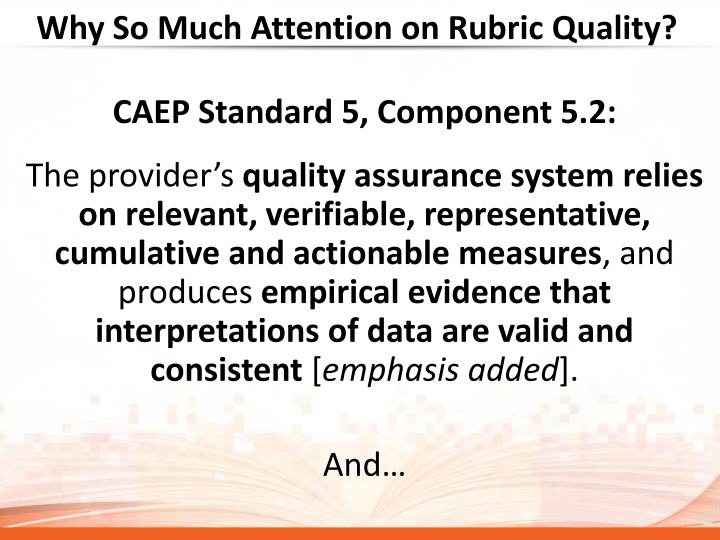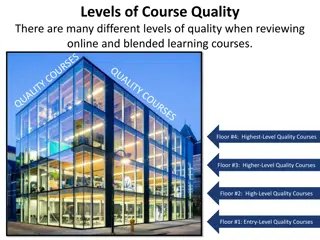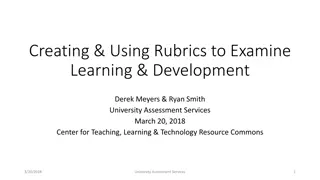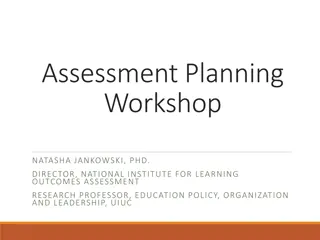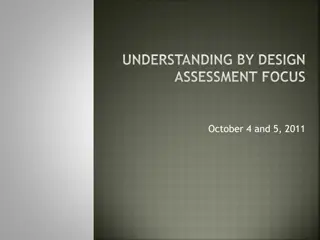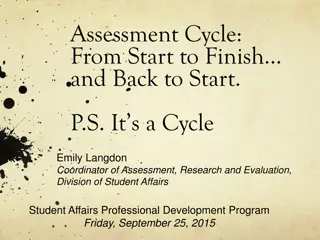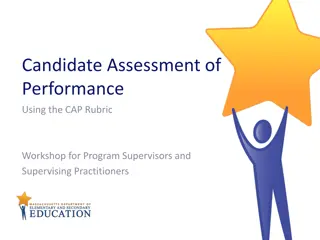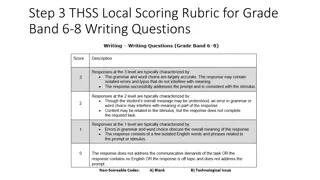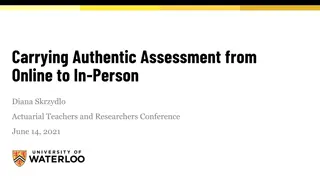Enhancing Rubric Quality in Educational Assessment
The focus on rubric quality in education, particularly in meeting CAEP Standard 5, Component 5.2 for quality assurance systems, is crucial for generating valid, reliable, and actionable data. CAEP now allows early submission of assessment instruments to improve data quality. However, common weaknesses in current rubrics must be addressed to ensure accurate assessment outcomes. Examples include broad criteria, double-barreled descriptors, and lack of alignment with learning outcomes. Improving rubric quality enhances assessment validity and informs instructional decision-making effectively.
Download Presentation

Please find below an Image/Link to download the presentation.
The content on the website is provided AS IS for your information and personal use only. It may not be sold, licensed, or shared on other websites without obtaining consent from the author.If you encounter any issues during the download, it is possible that the publisher has removed the file from their server.
You are allowed to download the files provided on this website for personal or commercial use, subject to the condition that they are used lawfully. All files are the property of their respective owners.
The content on the website is provided AS IS for your information and personal use only. It may not be sold, licensed, or shared on other websites without obtaining consent from the author.
E N D
Presentation Transcript
Why So Much Attention on Rubric Quality? CAEP Standard 5, Component 5.2: The provider s quality assurance system relies on relevant, verifiable, representative, cumulative and actionable measures, and produces empirical evidence that interpretations of data are valid and consistent [emphasis added]. And
Optional CAEP Review of Assessment Instruments CAEP has announced that its accreditation process will now allow the early submission of all key assessment instruments (rubrics, surveys, etc.) used by an Educator Preparation Provider (EPP) to generate data provided as evidence in support of CAEP accreditation. Once CAEP accreditation timelines are fully implemented, this will occur three years prior to the on-site visit to allow EPPs time to react to formative feedback from CAEP.
A Reality Check Regarding Current Rubrics: Commonly Encountered Weaknesses Using overly broad criteria Using double- or multiple-barreled criteria Using overlapping performance descriptors Failing to include all possible performance outcomes Using double-barreled descriptors that derail actionability Using subjective terms, performance level labels (or surrogates), or inconsequential terms to differentiate performance levels Failing to maintain the integrity of target learning outcomes: a common result of having multiple levels of mastery
Overly Broad Criterion Criterion Unsatisfactory Developing Proficient Distinguished Assessment No evidence of review of assessment data. Inadequate modification of instruction. Instruction does not provide evidence of assessment strategies. Instruction provides evidence of alternative assessment strategies. Some instructional goals are assessed. Some evidence of review of assessment data. Alternative assessment strategies are indicated (in plans). Lessons provide evidence of instructional modification based on learners' needs. Candidate reviews assessment data to inform instruction. Candidate selects and uses assessment data from a variety of sources. Consistently uses alternative and traditional assessment strategies. Candidate communicates with learners about their progress.
Double-barreled Criterion Criterion Unsatisfactory Developing Proficient Alignment to Applicable State P-12 Standards and Identification of Appropriate Instructional Materials Lesson plan does not reference P-12 standards or instructional materials. Lesson plan references applicable P-12 standards OR appropriate instructional materials, but not both. Lesson plan references applicable P-12 standards AND identifies appropriate instructional materials
Overlapping Performance Levels Criterion Unsatisfactory Developing Proficient Distinguished Communicating Learning Activity Instructions to Students Makes two or more errors when describing learning activity instructions to students Makes no more than two errors when describing learning activity instructions to students Makes no more than one error when describing learning activity instructions to students Provides complete, accurate learning activity instructions to students
Possible Gap in Performance Levels Criterion Unsatisfactory Developing Proficient Distinguished Instructional Materials Lesson plan does not reference any instructional materials Instructional materials are missing for one or two parts of the lesson Instructional materials for all parts of the lesson are listed and directly relate to the learning objectives. Instructional materials for all parts of the lesson are listed, directly relate to the learning objectives, and are developmentally appropriate.
Double-barreled Descriptor Criterion Unsatisfactory Developing Proficient Alignment to Applicable State P-12 Standards and Identification of Appropriate Instructional Materials Lesson plan does not reference P-12 standards or instructional materials. Lesson plan references applicable P-12 standards OR appropriate instructional materials, but not both. Lesson plan references applicable P-12 standards AND identifies appropriate instructional materials
Use of Subjective Terms Criterion Unsatisfactory Developing Proficient Distinguished Knowledge of Laboratory Safety Policies Candidate shows a weak degree of understanding of laboratory safety policies Candidate shows a relatively weak degree of understanding of laboratory safety policies Candidate shows a moderate degree of understanding of laboratory safety policies Candidate shows a high degree of understanding of laboratory safety policies
Use of Performance Level Labels Criteria Analyze Assessment Data Unacceptable Fails to analyze and apply data from multiple assessments and measures to diagnose students learning needs, inform instruction based on those needs, and drive the learning process in a manner that documents acceptable performance. Acceptable Analyzes and applies data from multiple assessments and measures to diagnose students learning needs, informs instruction based on those needs, and drives the learning process in a manner that documents acceptable performance. Target Analyzes and applies data from multiple assessments and measures to diagnose students learning needs, informs instruction based on those needs, and drives the learning process in a manner that documents targeted performance.
Use of Surrogates for Performance Levels Criterion Unsatisfactory Developing Satisfactorily written Proficient Well written Distinguished Very well written Quality of Writing Poorly written
Use of Inconsequential Terms Criteria Unacceptable Acceptable Target Alignment of Assessment to Learning Outcome(s) The content of the test is not appropriate for this learning activity and is not described in an accurate manner. The content of the test is appropriate for this learning activity and is described in an accurate manner. The content of the test is appropriate for this learning activity and is clearly described in an accurate manner.
Failure to Maintain Integrity of Target Learning Outcomes Criterion Unsatisfactory Developing Proficient Distinguished Alignment to Applicable State P-12 Standards No reference to applicable state P- 12 standards Referenced state P- 12 standards are not aligned with the lesson objectives and are not age- appropriate Referenced state P- 12 standards are age-appropriate but are not aligned to the learning objectives. Referenced state P-12 standards are age- appropriate and are aligned to the learning objectives. Criterion Unsatisfactory Developing Proficient Distinguished Instructional Materials Lesson plan does not reference any instructional materials Instructional materials are missing for one or two parts of the lesson Instructional materials for all parts of the lesson are listed and relate directly to the learning objectives. Instructional materials for all parts of the lesson are listed, relate directly to the learning objectives, and are developmentally appropriate.
Value-Added of High Quality Rubrics For Candidates, Well-designed Rubrics Can: Serve as an effective learning scaffold by clarifying formative and summative learning objectives (i.e., clearly describe expected performance at key formative transition points and at program completion) Identify the critical indicators aligned to applicable standards/ competencies (=construct & content validity) for each target learning outcome Facilitate self- and peer-evaluations
Value-Added of High Quality Rubrics For Faculty, Well-designed Rubrics Can: Improve assessment of candidates performance by: Providing a consistent framework for key assessments Ensuring the consistent use of a set of critical indicators (i.e., the rubric criteria) for each competency Establishing clear/concrete performance descriptors for each assessed criterion at each performance level Help ensure strong articulation of formative and summative assessments Improve validity and inter- and intra-rater reliability of assessment data Produce actionable candidate- and program-level data
Attributes of an Effective Rubric 1. Rubric and the assessed activity or artifact are well-articulated.
Attributes of an Effective Rubric (cont.) 2. Rubric has construct validity (i.e., it measures the right competency/ies) and content validity (rubric criteria represent all critical indicators for the competency/ies to be assessed). How do you ensure this?
Attributes of an Effective Rubric (cont.) 3. Each criterion assesses an individual construct No overly broad criteria No double- or multiple-barreled criteria
Attributes of an Effective Rubric (cont.) 4. To enhance reliability, performance descriptors should: Provide clear/concrete distinctions between performance levels (there is no overlap between performance levels) Collectively address all possible performance levels (there is no gap between performance levels) Eliminate (or carefully construct the inclusion of) double/multiple-barrel narratives
Attributes of an Effective Rubric (cont.) 5. Contains no unnecessary performance levels. Common problems encountered when multiple levels of mastery are present include: Use of subjective terms to differentiate performance levels Use of performance level labels or surrogates Use of inconsequential terms to differentiate performance levels Worst case scenario: failure to maintain the integrity of target learning outcomes
Attributes of an Effective Rubric 6. Resulting data are actionable To remediate individual candidates To help identify opportunities for program quality improvement Based on the first four attributes, the following meta- rubric has been developed for use in evaluating the efficacy of other rubrics
Some Additional Helpful Hints In designing rubrics for key formative and summative assessments, think about both effectiveness and efficiency Identify critical indicators for target learning outcomes and incorporate those into your rubric Limit the number of performance levels to the minimum number needed to meet your assessment requirements. HIGHER RESOLUTION IS BEST ACHIEVED WITH MULTIPLE FORMATIVE LEVELS, NOT MULTIPLE LEVELS OF MASTERY! Populate the target learning outcome column first (Proficient, Mastery, etc.) Make clear (objective/concrete) distinctions between performance levels; avoid the use of subjective terms in performance descriptors Be sure to include all possible outcomes Don t leave validity and reliability to chance Most knowledgeable faculty should lead program-level assessment work; engage stakeholders; align key assessments to applicable standards/competencies; focus on critical indicators Train faculty on the use of rubrics Conduct and document inter-rater reliability and fairness studies
